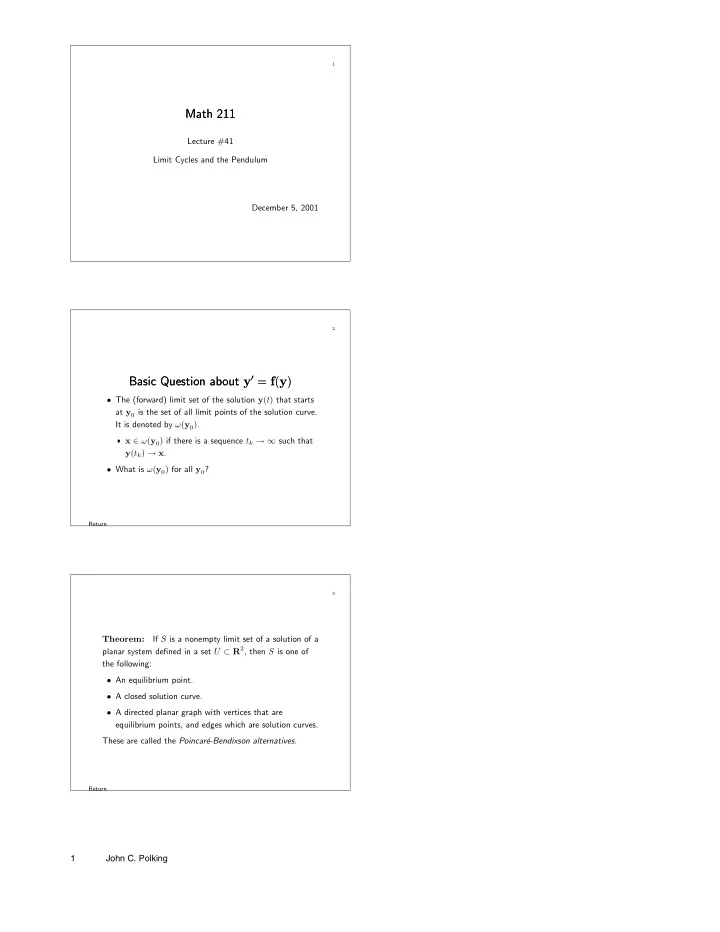

1 Math 211 Math 211 Lecture #41 Limit Cycles and the Pendulum December 5, 2001 2 Basic Question about y ′ = f ( y ) Basic Question about y ′ = f ( y ) • The (forward) limit set of the solution y ( t ) that starts at y 0 is the set of all limit points of the solution curve. It is denoted by ω ( y 0 ) . � x ∈ ω ( y 0 ) if there is a sequence t k → ∞ such that y ( t k ) → x . • What is ω ( y 0 ) for all y 0 ? Return 3 If S is a nonempty limit set of a solution of a Theorem: planar system defined in a set U ⊂ R 2 , then S is one of the following: • An equilibrium point. • A closed solution curve. • A directed planar graph with vertices that are equilibrium points, and edges which are solution curves. These are called the Poincar´ e-Bendixson alternatives. Return 1 John C. Polking
4 Poincar´ Poincar´ e-Bendixson Theorem e-Bendixson Theorem Suppose that R is a closed and bounded Theorem: planar region that is positively invariant for a planar system. If R contains no equilibrium points, then there is a closed solution curve in R . • The theorem is true if the set R is negatively invariant. Return Poincar´ e-Bendixson alternatives 5 Examples Examples • # 1. x ′ = x + y − x ( x 2 + 3 y 2 ) y ′ = − x + y − 2 y 3 � The set { ( x, y ) | 0 . 5 ≤ x 2 + y 2 ≤ 1 } is positively invariant. • # 2. Rayleigh’s example: z ′′ + µz ′ [( z ′ ) 2 − 1] + z = 0 . � There is a limit cycle. 6 The Pendulum The Pendulum • The angle θ satisfies the nonlinear differential equation mLθ ′′ = − mg sin θ − D θ ′ , or θ ′′ + D mLθ ′ + g L sin θ = 0 . � We will write this as θ ′′ + d θ + b sin θ = 0 . Return 2 John C. Polking
7 The Pendulum System The Pendulum System • Introduce ω = θ ′ to get the system θ ′ = ω ω ′ = − b sin θ − d ω • The equilibrium points are ( k π, 0) T where k is any integer. � If k is odd the equilibrium point is a saddle. � If k is even the equilibrium point is a center if d = 0 or a sink if d > 0 . Return Pendulum 8 The Inverted Pendulum The Inverted Pendulum • The angle θ measured from straight up satisfies the nonlinear differential equation mLθ ′′ = mg sin θ − D θ ′ , or θ ′′ + D mLθ ′ − g L sin θ = 0 . � We will write this as θ ′′ + d θ − b sin θ = 0 . Return Pendulum 9 The Inverted Pendulum System The Inverted Pendulum System • Introduce ω = θ ′ to get the system θ ′ = ω ω ′ = b sin θ − d ω • The equilibrium point at (0 , 0) T is a saddle point and unstable. • Can we find an automatic way of sensing the departure of the system from (0 , 0) T and moving the pivot to bring the system back to the unstable point at (0 , 0) T ? � Experimentally the answer is yes. Return Inverted pendulum Pendulum system 3 John C. Polking
10 The Control System The Control System • If we apply a force v moving the pivot to the right or left, then θ satisfies mLθ ′′ = mg sin θ − D θ ′ − v cos θ, • The system becomes θ ′ = ω ω ′ = b sin θ − d ω − u cos θ, where u = v/mL. • The force is a linear response to the detected values of θ and ω , so u = c 1 θ + c 2 ω , where c 1 and c 2 are constants. Return Inverted pendulum Inverted pendulum system 11 The Controlled System The Controlled System • The Jacobian at the origin is � 0 1 � J = b − c 1 − d − c 2 • The origin is asymptotically stable if T = − ( d + c 2 ) < 0 and D = c 1 − b > 0 . Therefore require c 1 > b = g c 2 > − d = − D and mL. L Return Inverted pendulum Inverted pendulum system Controls 4 John C. Polking
Recommend
More recommend